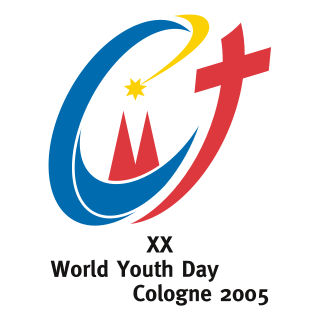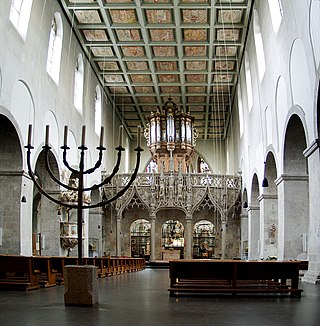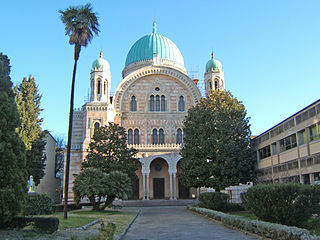
Cologne is the largest city of the German state of North Rhine-Westphalia and the fourth-most populous city of Germany with nearly 1.1 million inhabitants in the city proper and over 3.1 million people in the Cologne Bonn urban region. Cologne is also part of the Rhine-Ruhr metropolitan region, the second biggest metropolitan region by GDP in the European Union. Centered on the left (west) bank of the Rhine, Cologne is about 35 km (22 mi) southeast of the North Rhine-Westphalia state capital Düsseldorf and 25 km (16 mi) northwest of Bonn, the former capital of West Germany.

Kristallnacht (German pronunciation:[kʁɪsˈtalnaχt]lit. 'crystal night') or the Night of Broken Glass, also called the November pogrom(s) (German: Novemberpogrome, pronounced[noˈvɛm.bɐ.poˌɡʁoːmə] ), was a pogrom against Jews carried out by the Nazi Party's Sturmabteilung (SA) and Schutzstaffel (SS) paramilitary forces along with some participation from the Hitler Youth and German civilians throughout Nazi Germany on 9–10 November 1938. The German authorities looked on without intervening. The euphemistic name Kristallnacht comes from the shards of broken glass that littered the streets after the windows of Jewish-owned stores, buildings, and synagogues were smashed. The pretext for the attacks was the assassination of the German diplomat Ernst vom Rath by Herschel Grynszpan, a 17-year-old German-born Polish Jew living in Paris.

The Great Synagogue of Rome is the largest synagogue in Rome.

Michael Ritter von Faulhaber was a German Catholic prelate who served as Archbishop of Munich for 35 years, from 1917 to his death in 1952. Created Cardinal in 1921, von Faulhaber remained an outspoken monarchist and denounced the Weimar Republic as rooted in "perjury and treason" against the German Empire during a speech at the 62nd German Catholics' Day of 1922. Cardinal von Faulhaber was a senior member and co-founder of the Amici Israel, a priestly association founded in Rome in 1926 with the goal of working toward the Jewish people's conversion to Roman Catholicism, while also seeking to combat antisemitism within the Church.

The Oświęcim Synagogue, also called the Auschwitz Synagogue, is the only active synagogue in the town of Oświęcim, Poland. The formal, as well as pre-war, name of the synagogue is Chevre Loymdei Mishnayos. It is now part of the Auschwitz Jewish Center, which includes a Jewish Museum, a cafe in the house of Shimson Kleuger and an education center.

XX World Youth Day was a Catholic youth festival that started on 16 August and continued until 21 August 2005 in Cologne, Germany, commemorating the 20th anniversary of the first World Youth Day held in 1985. It was the first World Youth Day and foreign trip of Pope Benedict XVI, who joined the festival on 18 August. This meeting was decided by the previous pope, John Paul II, during the Toronto World Youth Day of 2002. The theme was "We have come to worship Him".

Langenlonsheim is an Ortsgemeinde – a municipality belonging to a Verbandsgemeinde, a kind of collective municipality – in the Bad Kreuznach district in Rhineland-Palatinate, Germany. It belongs to the Verbandsgemeinde Langenlonsheim-Stromberg, and is also its seat. Langenlonsheim is a state-recognized tourism community and a winegrowing village.

The Old Synagogue was a large structure in Przemyśl, Poland. It was completed in 1594. It was burned down in 1939 when the Germans were retreating from the eastern bank of the San River and the ruins were destroyed by the Nazis in 1941.

Mandel is an Ortsgemeinde – a municipality belonging to a Verbandsgemeinde, a kind of collective municipality – in the Bad Kreuznach district in Rhineland-Palatinate, Germany. It belongs to the Verbandsgemeinde of Rüdesheim, whose seat is in the municipality of Rüdesheim an der Nahe. Mandel is a winegrowing village.
The relations between Pope Benedict XVI and Judaism remained fairly good, although concerns were raised by Jewish leaders over the political impact of Traditionalists in the Church during the papacy of Benedict.
The canonization process of Pope Pius XII dates to shortly after his death in 1958. He was declared a servant of God in 1990 and venerable in 2009. Father Peter Gumpel was the relator of Pius XII's cause for canonization. The potential beatification of Pius XII has raised concern, especially by Jewish organisations, because of his controversial record during the Holocaust. The objections especially arise because of the refusal by the Vatican to allow independent access to the Vatican's archives for the period of Pius XII's papacy.

The White Stork Synagogue is a nineteenth-century synagogue in Wrocław, Poland. Rededicated in 2010 after a decade-long renovation, it is the religious and cultural centre of the local Jewish community, under the auspices of the Union of Jewish Religious Communities in Poland. It is the only synagogue in Wrocław to have survived the Holocaust.

The Church of Saint Pantaleon is an early Romanesque church in Cologne, Germany. The church dates back to the 10th century and is one of the twelve Romanesque churches of Cologne. The former monastery church is consecrated to Saint Pantaleon and the Saints Cosmas and Damian and is the oldest church of the cult of Saint Pantaleon west of Byzantium. The empress Theophanu and the archbishop Bruno the Great are buried in the church, which also contains shrines of saints Alban, the first Christian martyr of Britain, and Maurinus of Cologne. Pope Benedict XVI visited the church in 2005.
The Jewish Community of Gdańsk dates back to at least the 15th century though for many centuries it was separated from the rest of the city. Under Polish rule, Jews acquired limited rights in the city in the 16th and 17th centuries and after the city's 1793 incorporation into Prussia the community largely assimilated to German culture. In the 1920s, during the period of the Free City of Danzig, the number of Jews increased significantly and the city acted as a transit point for Jews leaving Eastern Europe for the United States and Canada. Antisemitism existed among German nationalists and the persecution of Jews in the Free City intensified after the Nazis came to power in 1933. During World War II and the Holocaust the majority of the community either emigrated or were murdered. Since the fall of communism Jewish property has been returned to the community, and an annual festival, the Baltic Days of Jewish Culture, has taken place since 1999.

The history of the Jews in Cologne dates to 321 C.E., when they were first recorded in a census decreed by Emperor Constantine I. As such, it is the oldest European Jewish community north of the Alps. The community quickly established itself in what came to be known as Cologne's Jewish quarter, building its first synagogue by 1040 C.E. The Crusades put an end to peaceful coexistence with Christians in 1096 C.E. Despite the Archbishop's protection many Jews were killed and their synagogue destroyed. The community regained its economic and religious life until about 1300 C.E., when the Christian majority again applied pressure. The community's fortunes improved and worsened a number of times into the 20th century. Before the 1930s, it consisted of 19,500 people. After the end of World War II it had been almost entirely extinguished due to Nazi destruction, expulsion and murder. Currently it numbers approximately 5,000.

The Erich Klibansky Platz in Cologne quarter Altstadt-Nord, located on Helenenstraße, takes the name of Erich Klibansky, the one-time and last headmaster of the Reformrealgymnasium Jawne, the first Jewish Gymnasium of the Rhineland. It took his name in 1990.

The history of the Jews in Florence can be traced over nine hundred years. Florence is the capital city of the Italian region of Tuscany and of the province of Florence. The Jews of Florence have one of the oldest continuous Jewish communities in Europe. The historic Jewish community in Florence is one of the largest and one of the most influential Jewish communities in Italy. The Jewish community in Florence also serves the smaller neighboring Jewish communities in Pisa, Livorno, and Siena.

The NS Documentation Centre of the City of Cologne(German: NS-Dokumentationszentrum der Stadt Köln) was founded by a resolution passed by the Cologne city council on December 13, 1979, and has become the largest regional memorial site in all of Germany for the victims of the Nazis. Since 1988, it has been housed in "EL-DE Haus," the EL-DE building, named for the initials of its owner, Catholic businessman Leopold Dahmen. This building was the headquarters of the Cologne Gestapo between December 1935 and March 1945. In the final months of the war, several hundred people, most of them foreign forced laborers, were murdered in the courtyard of the building. In a bit of historical irony, the EL-DE building remained largely untouched by the ravages of the war.

The history of the Jews in Affaltrach in Obersulm, Germany reaches back to the 17th century and ended during the Holocaust in the 20th century.
Like other areas under Nazi Germany, Jews were persecuted in the northernmost German state Schleswig-Holstein. Before the Nazis came to power in 1933, an estimated 1,900 Jews lived in Schleswig-Holstein, mostly in Lübeck and Kiel. By the time of Nazi Germany's defeat in 1945, many of Schleswig-Holstein's Jews had been murdered in the Holocaust.





















